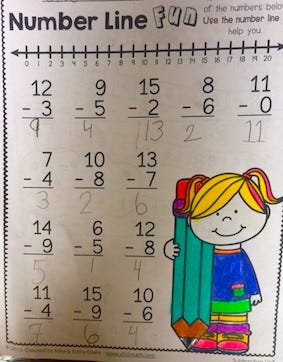When helping women reach parity in tech becomes obsessive
Or … adventures volunteering in my daughter’s 1st Grade classroom.
Or … adventures volunteering in my daughter’s 1st Grade classroom.
One of the gifts that comes with consulting is a flexible schedule that, barring any important investor or client meetings, has afforded me the chance to do pickups and drop offs, chaperone on field trips, and volunteer in the classroom. My favorite activity is assisting the kids in small groups during learning activities. I can see how they interact with each other, what concepts they struggle with, and I even get to witness some breakthroughs.
This week, in my daughter’s first grade classroom, I oversaw a group of four girls and one boy who had a four-page math exercise. The concepts were “fact families” or groups of numbers that could be organized as addition or subtraction problems, followed by a Base 5/Base 10 exercise and a “More than/Less than” exercise for numbers up to 100.
I watched the kids mull over the instructions on Page 1 and begin to fill out the fact families. Of the five kids, one or two had their fact families memorized and could fill in the numbers without resorting to counting their fingers or using an adding tool. Some I could hear counting to themselves. I encouraged each child to use whatever method worked best for him or her. While some of the kids were slower than others, it was clear that all of the kids understood the concept.
After about 10 minutes in, I had been working with one of the girls who was more methodical and stood up to survey everyone else’s work. Of the five kids, three of the girls and the one boy were plodding away on Page 1, while one of the girls was starting Page 3. I almost didn’t believe she had completed all the work, given the pace the others were working at.
I subtly peeked at her first two pages and found them complete and correct. And while the others needed some time to understand and integrate the instructions on page 1, she had quickly skimmed the instructions on page 3 and was already filling in “pumpkins” with Base 5 numbers and coloring the Base 10 pumpkins green, as instructed.
“Wow! Nice work!” I said, almost reactively, realizing I also needed to encourage the others who were working more slowly but thoroughly. At this, a number of the kids looked up and saw that the girl was far ahead, my own daughter being one of those kids. My daughter and the boy started to pick up their pace, continually eyeing the work of the girl who was on Page 3.
The Girl on Page 3 had no idea she was so far ahead and kept plotting her numbers. Once she finished she went back and started tracing over her work.
“Aren’t you going to start Page 4?” I asked.
“Nope,” she said. “I want to do bubble numbers.” She started converting each digit on Page 3 into a puffy, 3D version of its original self.
I noticed my immediate reaction: Such a shame, I thought. Here she was so far ahead of everyone else. She could breeze through the assignment with time to spare, but instead she wanted to decorate her work. In truth, she had plenty of time to finish all four pages, but I had this compulsion to coach her to finish. NOW.
By now the boy in the group was on Page 2 and working his way through quickly. I turned to the Girl on Page 3:
“But you’re almost done! Why don’t you start Page 4?”
What I wanted to say: “You can be first! YOU CAN WIN THE MATH ASSIGNMENT!”
The girl thought about what I said for a moment.
“Nope, that’s OK. I‘ll finish it later.”
Soon most of the kids in the group had seen the girl’s Page 3 and started coloring in pumpkins to match hers. My daughter started to draw bubble numbers in her pumpkins when I nudged her and said “focus on finishing, please.” She and the boy proceeded to page 4 and completed the whole assignment before time was called.
As I recalled this event to a friend later that day I wondered why this situation bothered me. Should I have encouraged the Girl on Page 3 more to finish the assignment? Should I not have given it another thought?
Or was I frustrated by different numbers? Numbers of girls with natural competencies in math and science who will never have careers that utilize these strengths? Or the numbers of women entrepreneurs who won’t get funding because not enough of us have made it to the finish line to convince largely male investors we have what it takes to invest in us?
Was it right to encourage a six-year-old girl to buy into a narrative that finishing at all costs — not the quality of the journey — was the only way? Is there really any harm in a little artistic flourish, some initiation of personal style enroute? It was clear she understood the principles that were presented. The others had even copied her work to complete theirs.
But I keep coming back to the reality: The burden of proof, and understanding the metrics that matter, even when they don’t necessarily matter to you.
I think, if I had a do-over, I would have suggested to the girl: Finish the assignment, then go back and make like RuPaul with your numbers. Show everyone you can pull it off with sparkles — but first, just pull it off.




